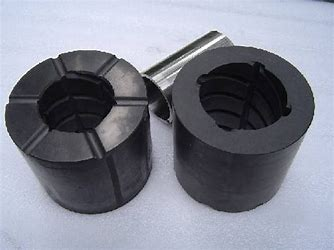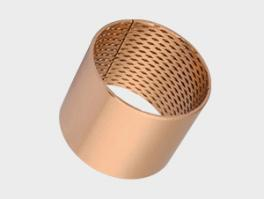Classification of sliding bearings: plastic bearings, graphite bearings, electromagnetic bearings, hydrodynamic bearings, gemstone bearings, gas bearings, etc. Different bearings have their own advantages, disadvantages, and application scenarios. Below, we will mainly introduce some widely used sliding bearings.
1. Plastic bearings
Commonly used plastics are used to make friction parts such as bearings, guide rails, piston rings, etc., such as water pump bearings, rolling mill bearings, stern bearings, etc. Especially, non lubricated bearings can be made of plastics. Stamping polytetrafluoroethylene sheets into lip shaped sealing rings, bearing shells, piston rings, and gaskets has been successfully applied to equipment such as belt conveyors, typewriters, sewing machines, record players, water pumps, textile machinery, and agricultural machinery.
Plastic has the characteristics of lightweight, insulation, friction reduction, wear resistance, self-lubrication, corrosion resistance, simple molding process, and high production efficiency. Compared with metal materials, their tribological properties are sensitive to environmental temperature and humidity, have significant characteristics related to viscoelasticity, have low mechanical strength, low elastic modulus, and poor adsorption ability to lubricating oil.
2. Graphite bearing
Carbon graphite generally has good conductivity, heat resistance, wear resistance, self-lubrication, high temperature stability, strong resistance to chemical corrosion, higher thermal conductivity than polymers, and lower linear expansion coefficient. The friction coefficient and wear rate with chromium plated surfaces are very low under atmospheric and room temperature conditions. But it loses its lubricity when the humidity is very low. Coating wear-resistant coatings can improve the wear resistance of carbon graphite.
Graphite can not only be used as a solid lubricant, but can also be added to materials such as resins, metals, ceramics, etc. to increase their anti friction properties. It can also be directly used as a friction material, such as in bearings, high-temperature sliding bearings, sealing rings, piston rings, scrapers, etc. in oil-free places such as papermaking, wood processing, textiles, food, etc. The "class" symbol for carbon graphite materials used in mechanical engineering is M, and there are four series: carbon graphite materials, electrochemical graphite materials, resin carbon composite materials, and metal graphite materials.
3. Electromagnetic bearing
Electromagnetic bearings, due to the lack of direct contact between the shaft and the bearing, do not require lubrication and can operate in vacuum and a wide temperature range. They have low frictional resistance and are not limited by speed (some have speeds as high as 23 million revolutions per minute and up to 3 times the speed of sound), long service life, and diverse structures. Electrostatic bearings require a large electric field strength, and their application is limited and can only be used in a few instruments. Magnetic bearings have large bearing capacity and stiffness, and have been used in ultra high speed trains, ultra high speed centrifuges, hydro generators, Angular momentum flywheels of space vehicles, flowmeters, densimeters, power meters, vacuum pumps, precision flow regulators and gyroscopes. With the development of magnetic materials and electronic technology, the application of electromagnetic bearings is increasingly expanding.
4. Hydrodynamic bearing
Single oil wedge bearings have a small eccentricity at high speeds and light loads, making them prone to instability and producing oil (gas) film oscillations. Oil film oscillation can cause major accidents such as equipment damage. Therefore, single oil wedge bearings are mostly used for mechanical equipment with medium or high speeds and heavy loads, such as rolling mills and general machine tools.
A bearing with two or more oil wedges around the journal of a multi oil wedge hydrodynamic radial bearing. Before the multi oil wedge radial bearing bears the load, that is, when the journal center coincides with the Centroid of the bearing, there is eccentricity relative to the curvature center of each section of the pad surface, but the eccentricity value is equal, the pressure generated in the oil film of each pad surface is the same, and the force on the journal is balanced.
After bearing the load, some of these eccentricity values increase or some decrease, and the oil film pressure on each bearing surface decreases or increases accordingly. The bearing capacity is the vector sum of these oil film pressures. Multi oil wedge bearings have lower load-bearing capacity than single oil wedge bearings, but there is additional oil film pressure on the opposite side of the main bearing pad, which can improve the stability of bearing operation. Therefore, multi oil wedge radial bearings are often used for high-speed and light load equipment, such as steam turbines, wind turbines, and precision grinding machines. There are many types of multi oil wedge radial bearings, and new structures with high vibration damping capabilities are constantly emerging.
Liquid dynamic pressure thrust bearing is a thrust bearing composed of several oil wedges, with a load-bearing capacity of the sum of the oil film pressures of each oil wedge. It is commonly used in equipment with medium or higher speeds such as water turbines, steam turbines, compressors, etc.
5. Tilting pad bearing
It has lower load-bearing capacity than single oil wedge hydrodynamic radial bearings, but has high rotational accuracy and good stability. It is widely used in high-speed and light load machinery, such as steam turbines and grinding machines. The number of tiles is generally 3-6. There are two ways to arrange tiles: the load is facing between adjacent tile supports and the load is facing a certain tile support. If the load is the same, the eccentricity of the latter shaft is smaller; If the thickness of the oil film on the bearing surface Z is the same, the former has high bearing capacity, low power consumption, and low temperature rise.
6. Gemstone bearing
Jewel bearing is a sliding bearing made of hard materials such as gemstones. Gem bearings are mainly used in instruments and meters. The bearing of instruments and meters bears a small load, but it needs to have high rotational accuracy, good sensitivity, and long service life. Gems have low friction, high hardness, corrosion resistance, low coefficient of thermal expansion, and high compressive strength, which can meet the requirements for the use of instrument bearings. The materials used to make gemstone shafts include corundum, agate, microcrystalline glass, etc. Corundum is a body of alumina, both natural and artificial. Natural corundum has many impurities and uneven texture, so artificial corundum is widely used.
7. Gas bearing
① Extremely low frictional resistance
② Wide applicable speed range
③ Wide temperature range
④ Low carrying capacity
⑤ High machining accuracy requirements
Gas bearings can be used in textile machinery, cable machinery, instrument machine tools, gyroscopes, high-speed centrifuges, dental drills, refrigerators operating at low temperature, hydrogen expanders and gas circulators operating at high temperature.
8. Oil bearing
Oily bearing is a sleeve bearing with Sliding friction, which uses lubricating oil as lubricant and drag reducing agent. In the initial use, it has low operating noise and low manufacturing cost. However, this kind of bearing is severely worn, and its service life is far behind that of ball bearing.
This type of bearing has been in use for a long time. Due to the use of oil seals (high-end oil seals, usually ordinary paper oil seals, are not possible for computer radiator products), the lubricating oil will gradually evaporate, and dust will also enter the bearings, causing problems such as slow fan speed and increased noise. In severe cases, it can also cause eccentric fan vibration due to bearing wear. If these phenomena occur, either open the oil seal for refueling, or simply eliminate and purchase a new fan.
It has the characteristics of low cost, vibration absorption, low noise, and no need to add lubricating oil for a long working time, especially suitable for working environments that are not easy to lubricate or do not allow oil to be dirty. Porosity is an important parameter of oil bearing. Oily bearings that operate at high speeds and light loads require a high oil content and high porosity; Oily bearings that operate at low speeds and high loads require high strength and low porosity. This type of bearing was invented in the early 20th century and has been widely used due to its low manufacturing cost and convenient use. It has become an indispensable basic component for the development of various industrial products such as automobiles, household appliances, audio equipment, office equipment, agricultural machinery, precision machinery, etc.
More about Epen E90 Bushing:
E90 bronze wrapped bushings are made of entirely bronze CuSn8. Because of material properties, the working surface rolled with diamond Indentations (standard Indentations) or stamped oil grooves according to detailed application. And it also has good performance of anti-corrosion caused by chemical and environments. During the operation, the grease & oil will be released from the indentations, which allow for long-term lubrication. Compare with machined bronze bearings, E90 can offer some advantages including thin wall, lower weight, cheaper cost, high load etc. It is suitable for high load, lower speed application like construction, transport, and agriculture machinery.
http://www.cnepen.com/showinfo-216-559-0.html





